
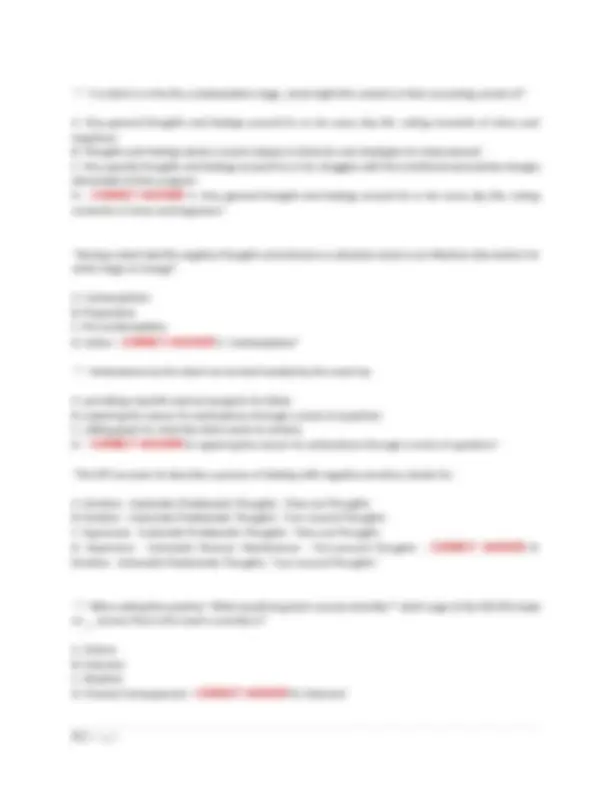
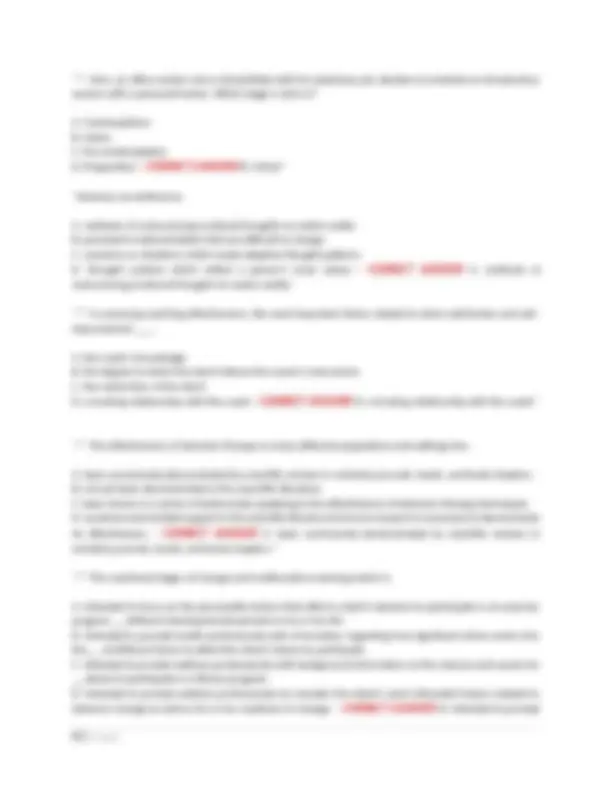
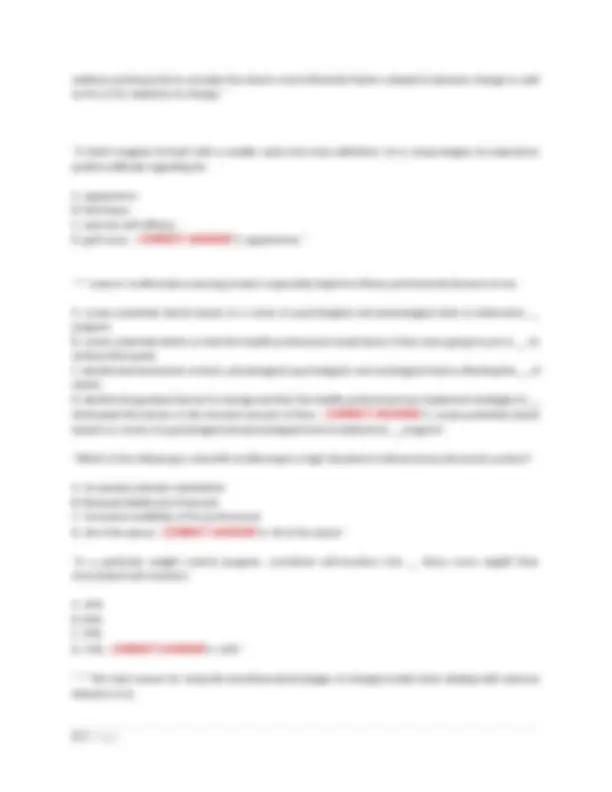
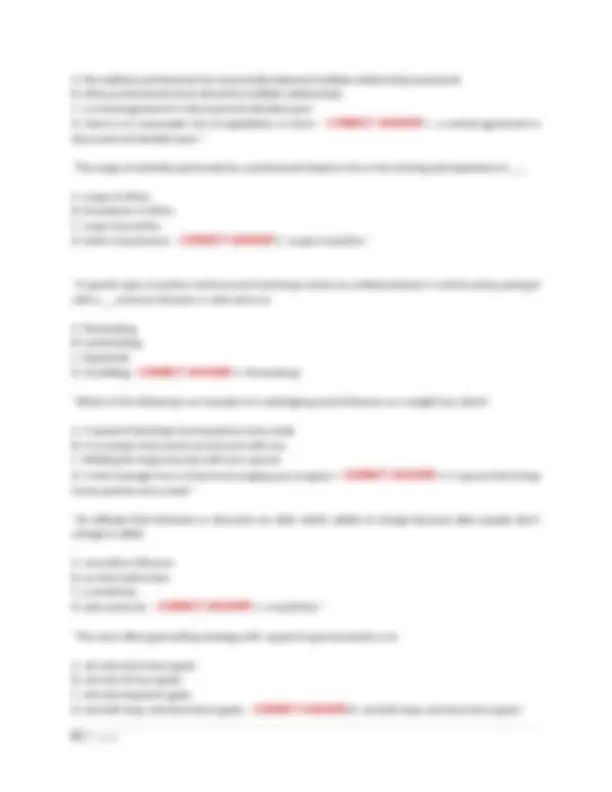
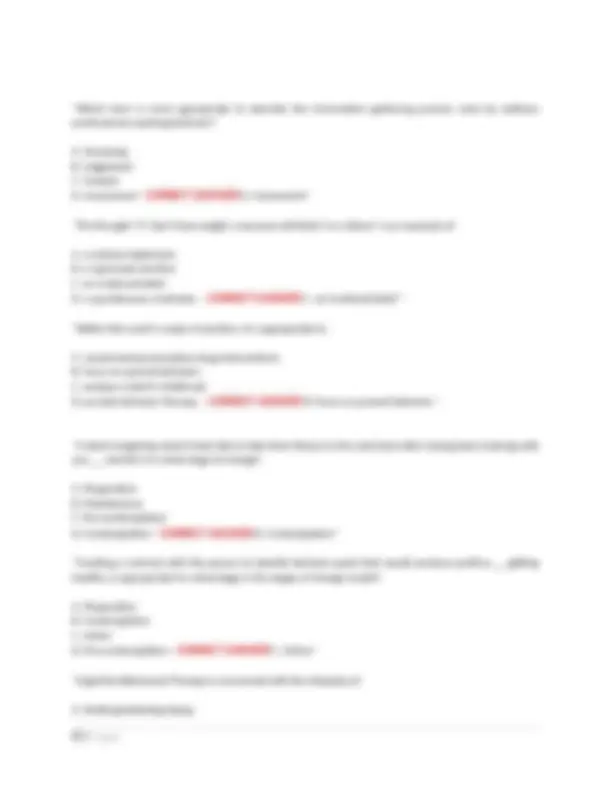
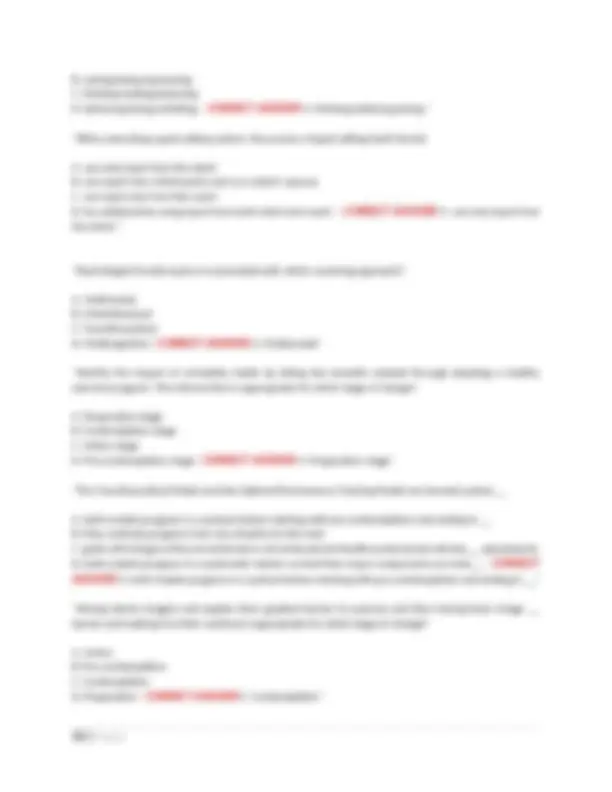
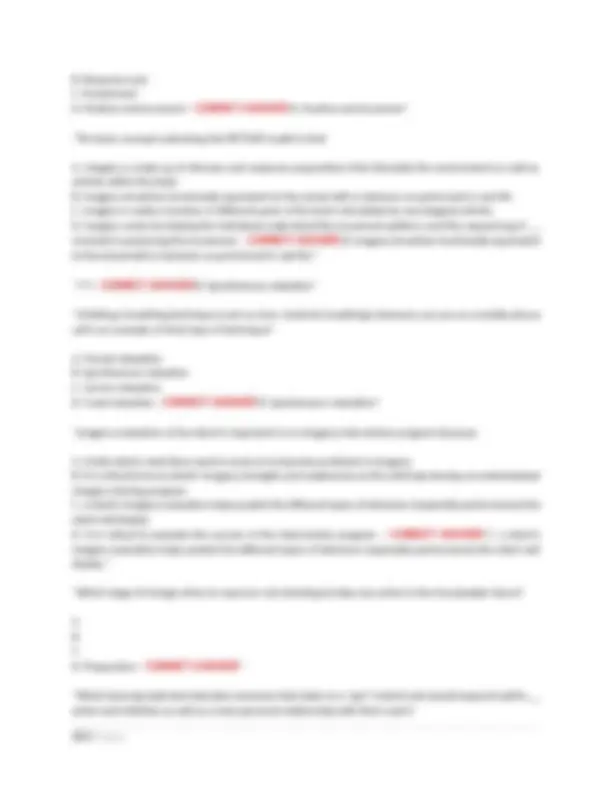
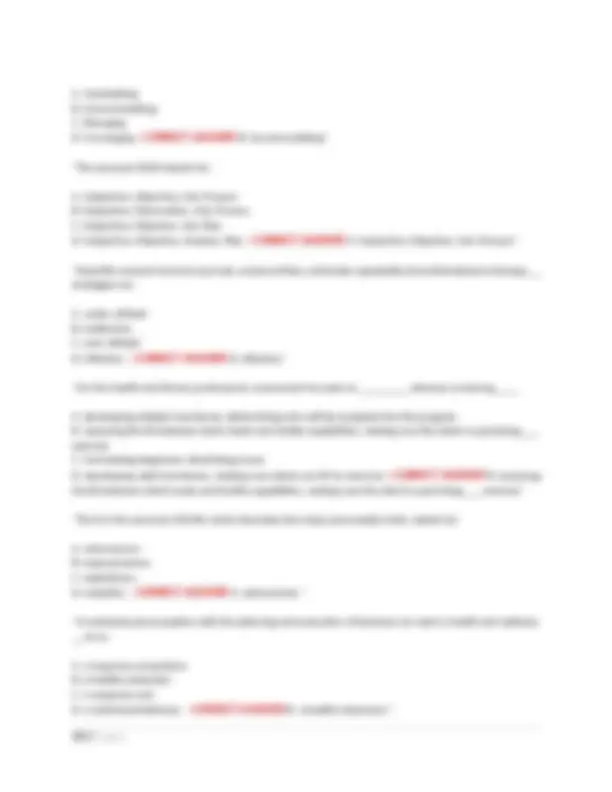
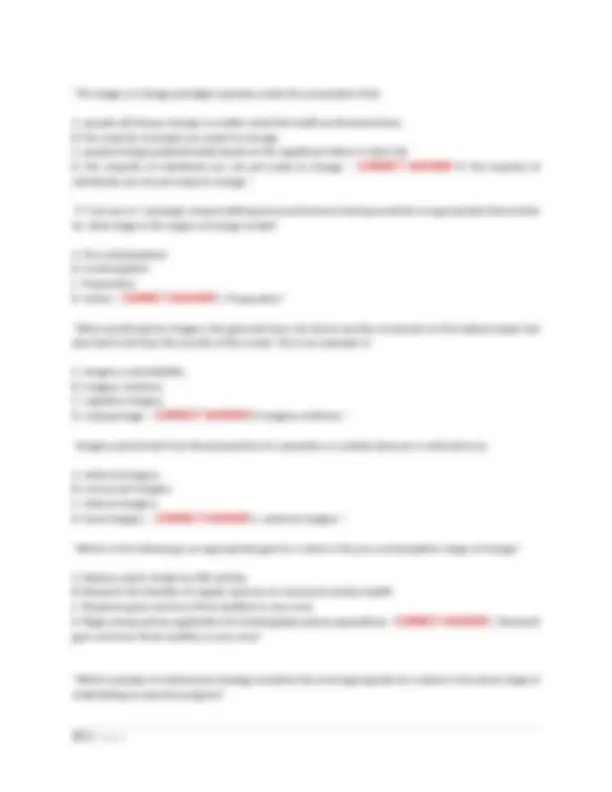
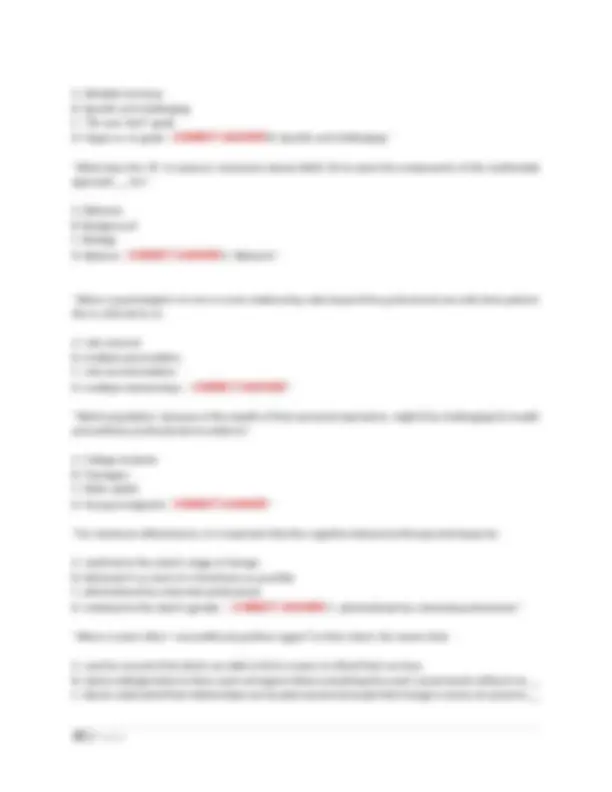
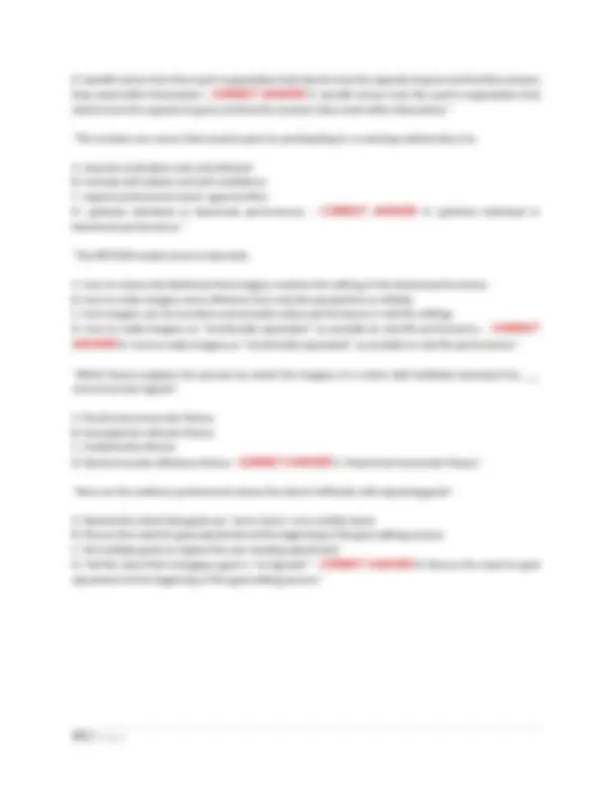


Study with the several resources on Docsity

Earn points by helping other students or get them with a premium plan


Prepare for your exams
Study with the several resources on Docsity

Earn points to download
Earn points by helping other students or get them with a premium plan
Community
Ask the community for help and clear up your study doubts
Discover the best universities in your country according to Docsity users
Free resources
Download our free guides on studying techniques, anxiety management strategies, and thesis advice from Docsity tutors
A series of multiple-choice questions related to behavior change, particularly in the context of wellness coaching. It covers topics such as client confidentiality, ethical considerations, stages of change, goal setting, and the use of imagery and multimodal screening models. Correct answers for each question, making it a valuable resource for students or professionals seeking to understand the principles and practices of behavior change.
Typology: Exams
1 / 19

This page cannot be seen from the preview
Don't miss anything!












"As a wellness professional will likely have written personal information about their clients, it is required that __ A. destroy all personal records after the professional relationship has ended. B. provide a copy of all paperwork to the client. C. maintain privacy and keep client information secure.
keep client information secure." "If a wellness professional chooses to engage in a sexual relationship with a previous client from years back, the wellness professional: A. should keep the relationship private as to maintain a professional reputation. B. bears the burden of demonstrating that there has been no exploitation. C. should make the relationship publicly known to make it legitimate and professional.
as long as the relationship is consensual." "The symptom checklist [SCL-90] can provide a general measure of psychological: A. imagery. B. optimism. C. forethought.
"Most importantly, goal setting should be a collaborative process with input from the coach and the client. This represents which aspect of a goal setting system? A. Planning and Education B. Generalization C. Evaluation and Reevaluation
"Choosing a healthy living website for a client's internet homepage is appropriate for which stage in the stage of change model? A. Action
B. Contemplation C. Pre-contemplation
"If you were using a problem-solving worksheet provided in the text with a client, what would be an example of the __ step in the problem solving process? A. The client realizing there is a problem with their adherence to the program B. The client listing off a set of potential strategies to try C. The client showing you a journey entry about the effectiveness of the chosen strategy
"It is important for coaches to understand Gardner's conception of multiple intelligences because: A. it can help them teach clients in multiple ways. B. it can help coaches devise a wide variety of exercise programs. C. it reminds coaches that they need to be introspective in thinking about using different types of intelligence in helping clients. D. it reminds coaches that there are different preferences in the way people/clients think which will
"The social intervention of the client checking in with two people every week to discuss their progress toward their health goals best suits which stage? A. Action B. Pre-contemplation C. Contemplation
"Which of the following is an appropriate application of the stages of change by a wellness professional? A. Selecting interventions to help progress the client through each stage B. Classifying the client by their stage of change for insurance purposes C. Deciding which type of exercise the client will find most enjoyable
Selecting interventions to help progress the client through each stage" "Exercise imagery can function to enhance which of the following for the client? A. Efficacy B. Technique C. Feelings
"** John, an office worker who is dissatisfied with his sedentary job, decides to schedule an introductory session with a personal trainer. Which stage is John in? A. Contemplation B. Action C. Pre-contemplation
"Schemas are defined as: A. methods of restructuring irrational thoughts to match reality B. persistent irrational beliefs that are difficult to change C. scenarios or situations which evoke adaptive thought patterns
restructuring irrational thoughts to match reality" "** In assessing coaching effectiveness, the most important factor related to client satisfaction and self- improvement ___ : A. the coach's knowledge B. the degree to which the client follows the coach's instructions C. the motivation of the client
"** The effectiveness of behavior therapy in many different populations and settings has: A. been conclusively demonstrated by scientific reviews in scholarly journals, books, and book chapters. B. not yet been demonstrated in the scientific literature. C. been shown in a series of testimonials speaking to the effectiveness of behavior therapy techniques. D. received some limited support in the scientific literature but more research is necessary to demonstrate
scholarly journals, books, and book chapters." "** The combined stages of change and multimodal screening matrix is: A. intended to focus on the personality factors that affect a client's decision to participate in an exercise program __ different developmental periods in his or her life. B. intended to provide health professionals with information regarding how significant others enter into the __ at different times to affect the client's desire to participate. C. intended to provide wellness professionals with background information on the reasons and causes for __ desire to participate in a fitness program. D. intended to prompt wellness professionals to consider the client's most influential factors related to
wellness professionals to consider the client's most influential factors related to behavior change as well as his or her readiness to change." "A client imagines himself with a smaller waist and more definition, he is using imagery to experience positive attitude regarding his: A. appearance. B. technique. C. exercise self-efficacy.
"** Lazarus' multimodal screening model is especially helpful to fitness professionals because it can: A. screen potential clients based on a series of psychological and physiological tests to determine __ program B. screen potential clients so that the health professional would know if they were going to put in __ to achieve their goals C. identify biomechanical, motoric, physiological, psychological, and sociological factors affecting the __ of clients D. identify the greatest barrier to change and then the health professional can implement strategies to __
based on a series of psychological and physiological tests to determine __ program" "Which of the following is a benefit of adhering to a high standard of ethical and professional conduct? A. Increased customer satisfaction B. Reduced likelihood of lawsuits C. Increased credibility of the professional
"In a particular weight control program, consistent self-monitors lost __ times more weight than inconsistent self-monitors. A. 64% B. 84% C. 94%
"** The main reason for using the transtheoretical [stages of change] model when dealing with exercise behavior is to:
A. susceptibility. B. compatibility. C. liability.
"Which of the following is an appropriate method for determining the effectiveness of their health behavior? A. The client reports that they are receiving plenty of social support. B. The client is progressing through the stages of change. C. The client is losing significant amounts of weight.
reports that they are receiving plenty of social support." "The stage paradigm of change operates on a fundamentally different assumption that: A. no individuals are ready for change. B. all individuals are ready to change. C. the minority of individuals are not ready for change.
are not ready to change." "The dimensions of personality as identified by Lazarus' Multimodal Screening Model follow "BASIC ID" which stands for: A. Brain, Attributions, Situations, Integrative, Cognition, Individualized, Cognition, Interpersonal, and Drugs B. Behavior, Affect, Situations, Integrative, Cognition, Individualized, and Dynamic C. Behavior, Affect, Sensation, Imagery, Cognition, Interpersonal, and Drugs
"The EAT method is effective for learning to identify and restructure automatic problem thoughts. What does EAT stand for? A. Emotional, Automatic Problem Thoughts, Turn-Around Thoughts B. Early Recognition, Analysis of Problem, Thought Restructuring C. Entry Thought, Alternative Thinking, Transition
Problem Thoughts, Turn-Around Thoughts" "Multiple relationships between a wellness professional and their client may NOT be an issue if:
A. the wellness professional has successfully balanced multiple relationships previously B. other professionals know about the multiple relationships. C. a mutual agreement is discussed and decided upon.
discussed and decided upon." "The range of activities performed by a professional based on his or her training and experience is __: A. scope of ethics. B. boundaries of ethics. C. scope of practice.
"A specific type of positive reinforcement technique where an unlikely behavior is reinforced by pairing it with a __ common behavior is referred to as: A. Premacking B. Landmarking C. Hyperbole
"Which of the following is an example of a sabotaging social influence on a weight loss client? A. A spouse that brings home pastries every week B. A co-worker that works out at lunch with you C. Walking the dog every day with your spouse
home pastries every week" "An attitude that dismisses or discounts an older adult's ability to change because older people don't change is called: A. normative influence. B. an informative bias. C. a social bias.
"The most effect goal setting strategy with respect to goal proximity is to: A. set only short-term goals. B. set only 24 hour goals. C. set only long-term goals.
B. seeing-doing-expressing. C. thinking-feeling-behaving.
"When executing a goal-setting system, the process of goal setting itself should: A. use only input from the client. B. use input from a third party such as a client's spouse. C. use input only from the coach.
the client." "Psychologist Arnold Lazarus is associated with which screening approach? A. Multimodal B. Interbehavioral C. Transtheoretical
"Identify the impact of unhealthy habits by listing five benefits realized through adopting a healthy exercise program. This intervention is appropriate for which stage of change? A. Preparation stage B. Contemplation stage C. Action stage
"The Transtheoretical Model and the Optimal Performance Training Model are termed cyclical __ A. both models progress in a cyclical fashion starting with pre-contemplation and ending in __ B. they routinely progress from one situation to the next. C. goals will change as they are achieved or not achieved and health professionals will also __ adjustments.
"Having clients imagine and explain their greatest barrier to exercise and then having them image __ barrier and making it to their workout is appropriate for which stage of change? A. Action B. Pre-contemplation C. Contemplation
“Which of the following is NOT considered a coaching communication competency? A. Establishing trust and rapport B. Providing answers to the client C. Asking appropriate questions
"The type of interpersonal influence where a client perceives the care that a wellness professional has for them refers to as: A. Normative influence B. Informative influence C. Technical influence
"What are three types of social influence? A. Social support, informative influences, and normative influences B. Physical activity and dietary guidelines, physician recommendations, and educational media C. Emotional support, instrumental support, and informational support
influences, and normative influences" "** An exerciser that is anxious and not confident about their ability to complete an exercise is experiencing a low amount of: A. self-efficacy B. self-awareness C. self-absorption
"Which of the following is a component of a successfully formulated goal? A. Has an open-ended timeframe B. Appears vague and undefined C. Distracts from the desired income
"The addition of a positive consequence after a desired behavior to increase the frequency of that behavior is referred to as: A. negative reinforcement B. punishment. C. positive reinforcement.
B. Response cost C. Punishment
"The basic concept underlying the PETTLEP model is that: A. imagery is made up of stimulus and response propositions that stimulate the environment as well as activity within the body B. imagery should be functionally equivalent to the actual skill or behavior as performed in real life. C. imagery is really a function of different parts of the brain stimulated by neurological activity. D. imagery works by helping the individual understand the movement patterns and the sequencing of __
to the actual skill or behavior as performed in real life."
"Initiating a breathing technique (such as slow, rhythmic breathing) whenever you are on a mobile phone call is an example of what type of technique? A. Forced relaxation B. Spontaneous relaxation C. Carrier relaxation
"Imagery evaluation of the client is important in an imagery intervention program because: A. it tells clients what they need to work on to become proficient in imagery. B. it is critical to know clients' imagery strengths and weaknesses as this will help develop an individualized imagery training program. C. a client's imagery evaluation helps predict the different types of behaviors (especially performance) the client will display.
imagery evaluation helps predict the different types of behaviors (especially performance) the client will display." "Which stage of change refers to a person not intending to take any action in the foreseeable future? A. B. C.
"Which learning style best describes someone that relies on a "gut" instinct and would respond well to __ action and initiative as well as a close personal relationship with their coach?
A. Assimilating B. Accommodating C. Diverging
"The acronym SOAP stands for: A. Subjective, Objective, Ask, Process B. Subjective, Observation, Ask, Process C. Subjective, Objective, Ask, Plan
"Scientific research found in journals, review articles, and books repeatedly show that behavior therapy __ strategies are: A. under-utilized. B. ineffective. C. over-utilized.
"For the health and fitness professional, assessment focused on _________ whereas screening ____ A. developing reliable inventories; determining who will be accepted into the program B. assessing the fit between client needs and facility capabilities; making sure the client is psycholog ___ exercise C. formulating diagnoses; identifying issues
the fit between client needs and facility capabilities; making sure the client is psycholog ___ exercise" "The E in the acronym OCEAN, which describes five major personality traits, stands for: A. extraversion. B. expressiveness. C. explicitness.
"A sustained preoccupation with the planning and execution of behaviors to reach a health and wellness __ to as: A. a response compulsion. B. a healthy obsession. C. a response cost.
A. Creating a contract to interval train 2 out of 4 cardio sessions per week B. Purchase a subscription to fitness magazines C. Begin researching local health clubs
out of 4 cardio sessions per week" "Which of the following is a stage of a goal setting system? A. Evaluation and Reevaluation B. Consensus C. Commitment
"Which of the following is an example of a process goal? A. Drink an extra 32 oz of water per day B. Reduce daily calorie intake from 3,000 to 1, C. Lose 20 pounds
"In the preparation stage, interventions specific to goal setting should: A. focus on creating goals that will help clients identify benefits of healthy changes specific to __ B. focus creating goals that help facilitate change. C. focus on creating goals that will help clients become better informed bout factors that affect __
creating goals to help clients prepare for a healthy lifestyle." "Inconsistent behavior change by the client can be treated effectively by the coach by: A. bringing in friends to help support the client. B. asking the client to keep a diary describing his/her feelings about making the specific change in behavior. C. providing specific long-term goals.
asking the client to keep a diary describing his/her feelings about making the specific change in behavior." "Which of the following is a strategy a coach may employ if their client has a hard time with self-reflection? A. The coach can explore why the client doesn't care about self-reflection. B. The coach may shift their strategies to focus on behavior change. C. The coach reminds the client of their motivation for wanting change.
client of their motivation for wanting change." "Effective contingency contracts have which of the following characteristics? A. Involve negotiation B. Rely on consequences C. Focus on change processes
"Having the client self-monitor their diet and exercise is an intervention best suited for which stage of change? A. Contemplation B. Action C. Maintenance
"A useful way to remember how to take effective notes is by the mnemonic SOAP, which stands for: A. Subjective, Objective, Analysis, and Plan. B. Specific, Overt, Apparent, and Private. C. Substantial, Ostensive, Assess, and Protect.
and Plan." "Clients tend to report satisfaction and self-improvement to the degree that there is: A. a session frequency of at least two times per week. B. limited financial hardship experienced as a result of sessions. C. a trusting relationship with the coach.
coach." "Which of the following is NOT mentioned as a common obstacle to achievement? A. Failure to set specific goals B. Setting too many goals too soon C. Setting goals that are aggressive
"Research clearly shows that which type of goals lead to higher levels of task performance?
D. benefit comes from the coach's expectation that clients have the capacity to grow and find the answers
clients have the capacity to grow and find the answers they need within themselves." "The number one reason that coaches give for participating in a coaching relationship is to: A. improve motivation and commitment. B. increase self-esteem and self-confidence. C. expand professional career opportunities.
teamwork performance." "The PETTLEP model serves to describe: A. how to reduce the likelihood that imagery matches the setting of the desired performance. B. how to make imagery more effective from only the perspective an athlete. C. how imagery can be overdone and actually reduce performance in real life settings.
"Which theory explains the process by which the imagery of a motor skill facilitates learning it by ___ neuromuscular signals? A. Psychoneuromuscular theory B. Sarcoplasmic reticular theory C. Acetylcholine theory
"How can the wellness professional reduce the client's difficulty with adjusting goals? A. Remind the client that goals are "set in stone" once written down B. Discuss the need for goal adjustment at the beginning of the goal setting process C. Set multiple goals to replace the one needing adjustment
adjustment at the beginning of the goal setting process"